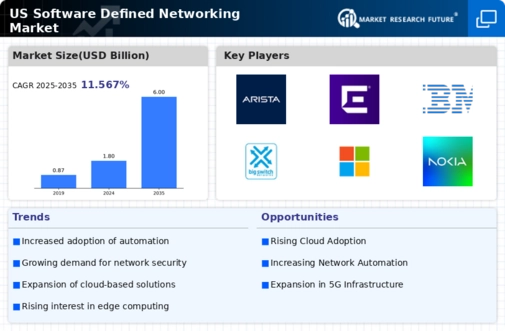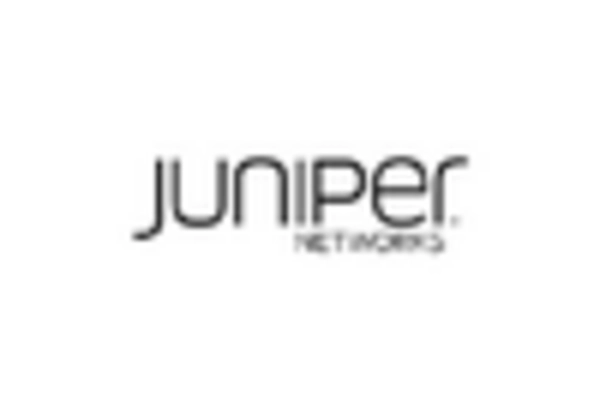Shift Towards Hybrid IT Environments
The shift towards hybrid IT environments is significantly influencing the software defined-networking market. Organizations are increasingly adopting a combination of on-premises and cloud-based solutions to optimize their IT infrastructure. This hybrid approach allows for greater flexibility, cost efficiency, and resource allocation. As a result, the software defined-networking market is likely to experience growth as businesses seek solutions that can seamlessly integrate various environments. Recent market analyses indicate that the hybrid IT segment is expected to account for over 40% of total IT spending in the coming years. This trend underscores the necessity for networking solutions that can effectively manage and orchestrate resources across diverse platforms.
Growing Demand for Network Scalability
The software-defined networking market is experiencing a notable surge in demand for network scalability. As organizations increasingly rely on digital transformation, the need for flexible and scalable network solutions becomes paramount. This trend is particularly evident in sectors such as finance and healthcare, where rapid data growth necessitates adaptable infrastructure. According to recent data, the market for scalable networking solutions is projected to grow at a CAGR of approximately 25% over the next five years. This growth is driven by the necessity for businesses to efficiently manage increasing data traffic while maintaining performance. Consequently, the software defined-networking market is positioned to benefit significantly from this demand, as it offers solutions that can dynamically adjust to varying workloads and user requirements.
Integration of Artificial Intelligence
The integration of artificial intelligence (AI) into the software defined-networking market is emerging as a transformative driver. AI technologies enable enhanced network management, predictive analytics, and automated troubleshooting, which are crucial for maintaining optimal network performance. Organizations are increasingly adopting AI-driven solutions to streamline operations and reduce downtime. Recent studies indicate that AI implementation in networking can lead to a reduction in operational costs by up to 30%. This trend suggests that as AI capabilities continue to evolve, the software defined-networking market will likely see increased investment and innovation, fostering a more efficient and responsive networking environment.
Regulatory Compliance and Data Privacy
Regulatory compliance and data privacy concerns are becoming critical drivers in the software defined-networking market. With the rise of stringent regulations such as the California Consumer Privacy Act (CCPA), organizations are compelled to adopt networking solutions that ensure compliance while safeguarding sensitive data. This has led to a heightened focus on secure networking architectures that can adapt to regulatory changes. The software defined-networking market is likely to see increased demand for solutions that offer robust security features and compliance capabilities. As organizations prioritize data protection, the market is expected to grow, with estimates suggesting a potential increase of 20% in demand for compliant networking solutions over the next few years.
Rising Need for Enhanced Network Performance
The rising need for enhanced network performance is a pivotal driver in the software defined-networking market. As businesses increasingly rely on real-time data and applications, the demand for high-performance networking solutions has intensified. Organizations are seeking to minimize latency and maximize throughput to support critical operations. This trend is particularly pronounced in industries such as e-commerce and media, where performance directly impacts customer experience. Recent reports suggest that investments in performance-enhancing networking technologies could increase by 15% annually. Consequently, the software defined-networking market is poised to capitalize on this demand, offering solutions that deliver superior performance and reliability.

















Leave a Comment